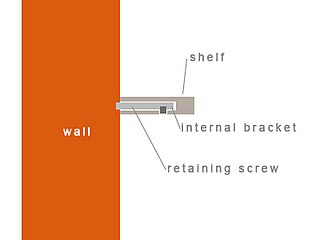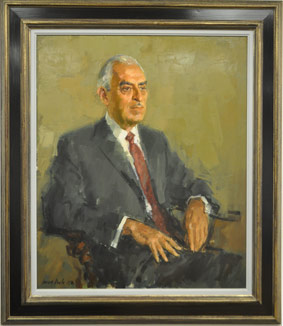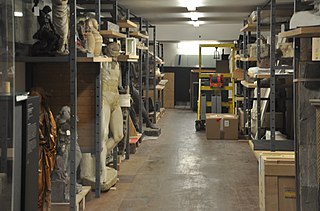
A bicycle frame is the main component of a bicycle, onto which wheels and other components are fitted. The modern and most common frame design for an upright bicycle is based on the safety bicycle, and consists of two triangles: a main triangle and a paired rear triangle. This is known as the diamond frame. Frames are required to be strong, stiff and light, which they do by combining different materials and shapes.

A bookcase, or bookshelf, is a piece of furniture with horizontal shelves, often in a cabinet, used to store books or other printed materials. Bookcases are used in private homes, public and university libraries, offices, schools, and bookstores. Bookcases range from small, low models the height of a table to high models reaching up to ceiling height. Shelves may be fixed or adjustable to different positions in the case. In rooms entirely devoted to the storage of books, such as libraries, they may be permanently fixed to the walls and/or floor.
A stillage is like a pallet or skid, but with a cage or sides, or some form of support specifically tailored to the material it is intended to carry. Some are designed to be stackable.

A bracket is an architectural element: a structural or decorative member. It can be made of wood, stone, plaster, metal, or other media. It projects from a wall, usually to carry weight and sometimes to "...strengthen an angle". A corbel or console are types of brackets.

Pallet rack is a material handling storage aid system designed to store materials on pallets. Although there are many varieties of pallet racking, all types allow for the storage of palletized materials in horizontal rows with multiple levels. Forklift trucks are usually required to place the loaded pallets onto the racks for storage. Since the Second World War, pallet racks have become a ubiquitous element of most modern warehouses, manufacturing facilities, retail centers, and other storage and distribution facilities. All types of pallet racking increase storage density of the stored goods. Costs associated with the racking increases with increasing storage density.

Material handling equipment (MHE) is mechanical equipment used for the movement, storage, control, and protection of materials, goods and products throughout the process of manufacturing, distribution, consumption, and disposal. The different types of equipment can be classified into four major categories: transport equipment, positioning equipment, unit load formation equipment, and storage equipment.

A baker's rack is a type of furniture with shelves, typically made of wrought iron or some other metal. "Since the 17th century, baker's racks have been part of many homes around the world. This versatile storage furniture has gained its name because it has been originally used by bakers." The shelves are made of a conductive material, often steel or iron, which served to help cool a baker's goods such as hot pies, breads, and pastries. The conductivity and thermal mass of metal not only allows for heat to be quickly transferred from the pan to the shelf, but held for a long time. This allowed the cooling process to be equally distributed so baked goods maintained their integrity.
Wire Shelving is commonly used in industrial and commercial platforms, and more recently in residential use. It is also known as wire decking or ventilated shelving.

A floating shelf is a form of shelf with its wall fixings hidden within the shelf board, with no visible supporting brackets.

Pipe and drape is a style of freestanding panelling used to divide, hide, and/or decorate a space temporarily. The structure consists of aluminum or steel piping fixed or adjustable telescoping vertical uprights supported by a weighted steel base, and adjustable telescopic or fixed horizontals that provide a drape support frame with removable drape panels.

Strut channel, often referred to colloquially by one of several manufacturer trade names, is a standardized formed structural system used in the construction and electrical industries for light structural support, often for supporting wiring, plumbing, or mechanical components such as air conditioning or ventilation systems.

A shelf is a flat, horizontal plane used for items that are displayed or stored in a home, business, store, or elsewhere. It is raised off the floor and often anchored to a wall, supported on its shorter length sides by brackets, or otherwise anchored to cabinetry by brackets, dowels, screws, or nails. It can also be held up by columns or pillars. A shelf is also known as a counter, ledge, mantel, or rack. Tables designed to be placed against a wall, possibly mounted, are known as console tables, and are similar to individual shelves.

Demetrius Comino OBE was an Australian engineer, inventor, entrepreneur and philanthropist during the 20th century. He invented the slotted angle steel construction system, Dexion, which became widely used internationally for commercial shelving, storage racking, exhibition stands, accommodation, and for domestic purposes. In 1971 he founded the Comino Foundation, an educational charity.

Slotted angle is a system of reusable metal strips used to construct shelving, frames, work benches, equipment stands and other structures. The name derives, first, from the use of elongated slots punched into the metal at uniform intervals to enable assembly of structures fixed with nuts and bolts, and second, from the longitudinal folding of the metal strips to form a right angle.

Dexion is a company name and brand particularly associated with the development of the "Dexion" slotted angle steel strip construction system, widely used since the 1950s for domestic and commercial shelving, storage racking, exhibition stands and accommodation purposes.
Constructor Group AS is a Norwegian-registered international company, with headquarters in Oslo, that specialises in the manufacture and supply of shelving, mobile shelving, pallet racking and similar storage systems, primarily for commercial use in offices, factories, warehouses, museums, archives, libraries and retail outlets.

A cabinet is a case or cupboard with shelves and/or drawers for storing or displaying items. Some cabinets are stand alone while others are built in to a wall or are attached to it like a medicine cabinet. Cabinets are typically made of wood, coated steel, or synthetic materials. Commercial grade cabinets usually have a melamine-particleboard substrate and are covered in a high-pressure decorative laminate, commonly referred to as Wilsonart or Formica.

In library science and architecture, a stack or bookstack is a book storage area, as opposed to a reading area. More specifically, this term refers to a narrow-aisled, multilevel system of iron or steel shelving that evolved in the 19th century to meet increasing demands for storage space. An "open-stack" library allows its patrons to enter the stacks to browse for themselves; "closed stacks" means library staff retrieve books for patrons on request.

The cultural property storage typically falls to the responsibility of cultural heritage institutions, or individuals. The proper storage of these objects can help to ensure a longer lifespan for the object with minimal damage or degradation. With so many different types of artifacts, materials, and combinations of materials, keepers of these artifacts often have considerable knowledge of the best practices in storing these objects to preserve their original state.

A shelf support is a fastener used to hang a shelf from a wall. It can be an alternative to built-in shelving or adjustable shelving.
















